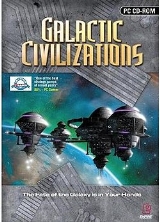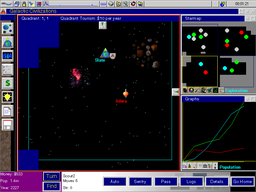
Galactic Civilizations
Encyclopedia
Galactic Civilizations is a turn-based strategy
computer game developed by Stardock
and released in March 2003. The game is a remake of a vintage OS/2
series of the same name. An expansion pack entitled Altarian Prophecy was released in July 2004. A sequel, Galactic Civilizations II: Dread Lords
, was released February 21, 2006.
The most noteworthy feature of Galactic Civilizations is the AI. The computer players are surprisingly realistic and intelligent. However, there is no multiplayer.
The game requires the player to play as the humans, but they can be heavily modified. Each computer player has its own artificial intelligence routines, and they each have specific and noticeable personalities.
Two new races were added into the game via the Altarian Prophecy expansion pack.
. Although revenue from the initial OS/2 release was never paid by the bankrupt publisher, popular support encouraged Stardock to release Shipyards, an add-on pack that allowed users to design their own starships, and this provided enough revenue to support further development, with a simplified version being sold to IBM
in 1995 as Star Emperor.
 Galactic Civilizations 2 was released later that year, adding several new concepts and tweaks. It was followed by another version of Shipyards (which added both the ship design feature and improved governors/AI), and an expansion pack in April 1997, before Stardock was forced to withdraw from significant OS/2 development with the loss of their market.
Galactic Civilizations 2 was released later that year, adding several new concepts and tweaks. It was followed by another version of Shipyards (which added both the ship design feature and improved governors/AI), and an expansion pack in April 1997, before Stardock was forced to withdraw from significant OS/2 development with the loss of their market.
It is possible to run OS/2 versions of the game under emulation using Virtual PC.
Turn-based strategy
A turn-based strategy game is a strategy game where players take turns when playing...
computer game developed by Stardock
Stardock
Stardock Corporation is a software development company founded in 1991 and incorporated in 1993 as Stardock Systems. Stardock initially developed for the OS/2 platform, but was forced to switch to Windows due to the collapse of the OS/2 software market between 1997 and 1998...
and released in March 2003. The game is a remake of a vintage OS/2
OS/2
OS/2 is a computer operating system, initially created by Microsoft and IBM, then later developed by IBM exclusively. The name stands for "Operating System/2," because it was introduced as part of the same generation change release as IBM's "Personal System/2 " line of second-generation personal...
series of the same name. An expansion pack entitled Altarian Prophecy was released in July 2004. A sequel, Galactic Civilizations II: Dread Lords
Galactic Civilizations II: Dread Lords
Galactic Civilizations II: Dread Lords is a 4X turn-based strategy computer game by Stardock...
, was released February 21, 2006.
Gameplay
The goal of the game is to eventually dominate the galaxy. It is possible to achieve victory through war, cultural domination, diplomacy or by developing overwhelming advanced technology.The most noteworthy feature of Galactic Civilizations is the AI. The computer players are surprisingly realistic and intelligent. However, there is no multiplayer.
The game requires the player to play as the humans, but they can be heavily modified. Each computer player has its own artificial intelligence routines, and they each have specific and noticeable personalities.
Story
The game is set in the future. Humankind has made contact with the 5 other major alien races. Space travel is risky and expensive, requiring huge jump gates which only permit travel between two specific points. Because space travel is so difficult, the galaxy remains mostly uncolonized. The humans make a great discovery—hyperdrive. It permits fast travel between any two stars. The humans share their discovery with the other five major races. All communication stops. The humans consider that sharing their discovery may have been a mistake. Now that the galaxy is open for exploration, there's going to be a rush to claim all the uncolonized worlds.Civilizations
- Terran Alliance
- This is the civilization that the player must always use. It is fully customizable and renameable by the player. The AI will still refer to them as "human." The player can also choose any combination of party/racial modifiers, so they can pursue different styles of play and are not restricted by morality or belligerence.
- Drengin Empire
- A vile race. The Drengin are aggressive and military-oriented, making them dangerous in the small galaxy sizes though they lack long-term staying power in the larger ones.
- Altarian Resistance
- "Saintly crusaders" explains this civilization's intentions. The Altarians look just like Terrans, but have "psychic" powers. Though they are Pure Good, the Altarians are quick to destroy any Evil civilization unless said society is providing, through trade, much of their income.
- Arcean Empire
- "Unbiased" probably best describes the Arceans, as they are considered to be a neutral civilization. Neither good nor evil, the Arceans are the least biased race in the galaxy and don't take other civilizations' moralities into consideration in the midst of diplomacy.
- Yor Collective
- A race of evil machines that want to destroy all life in the galaxy.
- Torian Confederation
- A race of aliens, the Torians are (in the standard game) Chaotic Good. The Torians quickly developed a civilization — and were taken over by the Drengin. After vanquishing the Drengin on their homeworld, the Torians started their new civilization.
Two new races were added into the game via the Altarian Prophecy expansion pack.
- Dominion of the Korx
- A pure evil mercantile race, the Korx are (in the standard game) similar to the Arceans in that they appear to have a middle-term thinking pattern. Little is really known about the Korx, but this perhaps spawns from the fact that they were once a Minor Race.
- Drath Legion
- A mysterious reptilian race that appears to hold a grudge against the Altarians, and are stated to be Pure Evil.
Development
Galactic Civilizations was first developed for OS/2 in April 1993 by Brad WardellBrad Wardell
Bradley R. Wardell , commonly known as Brad Wardell, is an American businessman, programmer and author residing in Michigan...
. Although revenue from the initial OS/2 release was never paid by the bankrupt publisher, popular support encouraged Stardock to release Shipyards, an add-on pack that allowed users to design their own starships, and this provided enough revenue to support further development, with a simplified version being sold to IBM
IBM
International Business Machines Corporation or IBM is an American multinational technology and consulting corporation headquartered in Armonk, New York, United States. IBM manufactures and sells computer hardware and software, and it offers infrastructure, hosting and consulting services in areas...
in 1995 as Star Emperor.

It is possible to run OS/2 versions of the game under emulation using Virtual PC.

